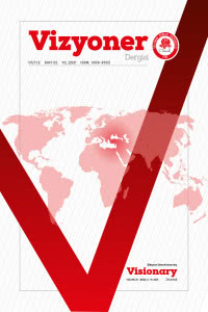AVRUPA BİRLİĞİ ÖRNEĞİNDE ULUSLARARASI SPOR POLİTİKASININ GELİŞİMİ: EKONOMİK, SOSYAL VE SİYASAL BOYUT
Spor, Lizbon Antlaşması ile AB’nin yetki alanlarından biri haline gelmiştir. AB sporu siyasi ve sosyo-ekonomik bir araç olarak ele almakta ve ekonomi, sosyal politika, dış ilişkiler gibi diğer politika alanlarının amaçlarının gerçekleştirilmesine katkıda bulunabilecek bir uluslararası politika aracı olarak değerlendirmektedir. Uluslarüstü bir spor politikası henüz oluşmamış olsa da, AB bu alandaki etkinliğini programları ve fonları yoluyla arttırmaktadır
Anahtar Kelimeler:
Avrupa Birliği, spor, uluslararası politika
DEVELOPMENT OF INTERNATIONAL SPORTS POLICY IN THE CASE OF EUROPEAN UNION: ECONOMIC, SOCIAL AND POLITICAL ASPECTS
Sports was included in EU competences with the Lisbon Treaty. EU handles sports as a political and socio-economic instrument and assesses it as an international policy tool that can contribute to the realization of the goals of other policy areas such as economic, social and external relations policies. Although a supranational sports policy has not emerged yet, the EU has been increasing its effectiveness in this field through its programmes and funds
Keywords:
European Union, sports, international policy,
___
- BÖRZEL, Tanja A. (1997), “What's So Special About Policy Networks? - An
- Exploration of the Concept and Its Usefulness in Studying European Governance”, European Integration Online Papers, Volume 1, No 16, http://eiop.or.at/eiop/pdf/1997-016.pdf, 10.10.2013.
- COAKLEY, Jay (2001), Sport in Society: Issues and Controversies, McGraw-Hill, Boston.
- COMMITTEE ON CULTURE AND EDUCATION (2011), Report on the European Dimension in Sport, Rapporteur Santiago Fisas Ayxela, Brussels.
- COUNCIL OF EUROPE (2001), “The European Sports Charter”. http://www.coe.int/t/dg4/epas/resources/charter_en.asp, 15.12.2013.
- ECONOMISTI ASSOCIATI SRL vd. (2011), “Evaluation of Preparatory Actions http://ec.europa.eu/sport/news/doc/evaluation_final_report_prepact_special_e vents_20110727.pdf, 20.12.2013. in the Field of Sport”,
- EU/EGYPT ACTION PLAN (2007), http://ec.europa.eu/world/enp/pdf/action_plans/egypt_enp_ap_final_en.pdf, 12.2013.
- EUROBAROMETER (2010), “Sport and Physical Activity”, Special Eurobarometer http://ec.europa.eu/sport/library/documents/d/ebs_334_en.pdf, 24.11.2013. No: , Brussels,
- EUROBAROMETER (2004), “The Citizens of the European Union and Sport”, http://ec.europa.eu/sport/documents/publications/ebs_213_report_en.pdf, 11.2013. Eurobarometer No: , Brussels.
- EUROPEAN COMMISSION (2013a), “Structured Dialogue with Sports
- Organisations”, http://ec.europa.eu/sport/consultation-cooperation/structured- dialogue-with-sports-organisations_en.htm, 20.12.2013.
- EUROPEAN COMMISSION (2013b), “The Sport Unit and Its Mission”, http://ec.europa.eu/sport/who-we-are/the-sport-unit-and-its-mission_en.htm, 12.2013.
- EUROPEAN COMMISSION (2013c), “Sport in the EU’s External Relations”, sport_en.htm#2_7, 22.12.2013.
- EUROPEAN COMMISSION (2013d), Erasmus+ Programme Guide, Brussels.
- EUROPEAN COMMISSION (2011), “Developing the European Dimension in Sport”, Brussels, http://eurlex.europa.eu/LexUriServ/LexUriServ.do?uri=COM:2011:0012:FIN :en:PDF, 05, 10.2013.
- EUROPEAN COMMISSION (2010), Europe 2020: A Strategy for Smart,
- Sustainable and Inclusive Growth, Brussels. EUROPEAN COMMISSION (2007a), “White Paper on Sport”, Brussels, http://ec.europa.eu/sport/documents/wp_on_sport_en.pdf, 22.12.2013.
- EUROPEAN COMMISSION (2007b), “Staff Working Document Impact Assessment http://ec.europa.eu/sport/documents/dts935_en.pdf, Brussels, 22.12.2013. the White Paper on Sport”,
- EUROPEAN OLYMPIC COMMITTEES EU OFFICE, “Mainstreaming Sport into EU Funding Programmes”, http://www.euoffice.eurolympic.org/cms/getfile.php?186, 10.12.2013.
- INSTITUTE FOR CULTURAL DIPLOMACY (2011), “Sport as Cultural
- Diplomacy”, Cultural Diplomacy Outlook Report, Institute for Cultural Diplomacy, Berlin. KISSOUDI, P. (2008), “Sport, Politics and International Relations in the Twentieth Century”, The International Journal of the History of Sport, Volume 25, Issue 13, ss. 1689-1706.
- KORNBECK, J. (2013). Inspiration from Brussels? The European Union and Sport. Europäischer Hochschulverlag GmbH & Co, Bremen.
- MARKS, Garry (1993), “Structural Policy and Multilevel Governance in the EC”, Ed. A. Cafruny ve G. Rosenthal, The State of the European Community,
- Lynne Rienner, Boulder, ss. 391-410. MURRAY, S. (2011). “Sports-Diplomacy: a Hybrid of Two Halves”, The International Symposium on Cultural Diplomacy Participant’s Papers,
- Institute for Cultural Diplomacy, Berlin. OOIJEN, Bart (2009), “Perspective of European Commission- Sport: a
- ‘language’ of Europe”, http://www.languagesmeetsport.eu/pdf/PlenarySession/8_sport_a_language_ of_europe.pdf, 25.12.2013.
- OSTLINNING, Freya Elisa (2011), Running for Europe EU Sports Policy and the Role of Civil Society, Unpublished PhD Dissertation, Westphalian
- Wilhelms University, Münster. RITCHIE B. ve D. Adair (2004),“Sport Tourism: An Introduction and Overview”, Ed. Brent W. Ritchie ve Daryl Adair, Sport Tourism:
- Interrelationships, Impacts and Issues, Channel View Publications, Clevedon. TRAUNER, F. ve I. Kruse, (2008),“EU Visa Facilitation and Readmission
- Agreements: Implementing a New EU Security Approach in the Neighbourhood”, CEPS Working Document 290, CEPS Publications, Brussels. UN SPORT FOR DEVELOPMENT AND PEACE INTERNATIONAL WORKING GROUP (2013), http://www.un.org/wcm/content/site/sport/home/unplayers/memberstates/pid/ , 15.12.2013.
- UNITED NATIONS (2012a), “Achieving the Objectives of United Nations Through Sport” www.un.org/wcm/webdav/site/sport/shared/sport/pdfs/Backgrounders/NEW
- %20UNOSDP%20Backgrounder.pdf, 02.01.2012.
- UNITED NATIONS (2012b), “Sport as a Tool for Development and Peace
- Towards Achieving United Nations Millennium Development Goals”, http://www.un.org/sport2005/resources/task_force.pdf, 02.01.2012.
- Yayın Aralığı: Yılda 4 Sayı
- Başlangıç: 2009
- Yayıncı: Süleyman Demirel Üniversitesi
Sayıdaki Diğer Makaleler
SİVİL TOPLUM KURULUŞLARINDA KIYASLAMA: YÖNETİCİ VE ÜYE PERSPEKTİFİ
Metin Nezih ÖZMUTAF, Nisa AKIN
Nuri Ömürbek, Mükrime Öksüz DEMİRGUBUZ, MUSTAFA ZİHNİ TUNCA
Sine Erdoğan MORÇİN, İlhami MORÇİN
Mehmet Dinç, Ferhat Bitlisli, Esra ÇETİNCELİ, Sonay Zeki Aydın
Evrim Mayatürk Akyol, Zehra Nuray NİŞANCI, Nezih Metin Özmutaf
İKTİSADİ AÇIDAN BİLGİ KAVRAMI VE BİLGİ KAVRAMINA YAKLAŞIMLAR ÜZERİNE BİR İNCELEME
AVRUPA BİRLİĞİ ÖRNEĞİNDE ULUSLARARASI SPOR POLİTİKASININ GELİŞİMİ: EKONOMİK, SOSYAL VE SİYASAL BOYUT
